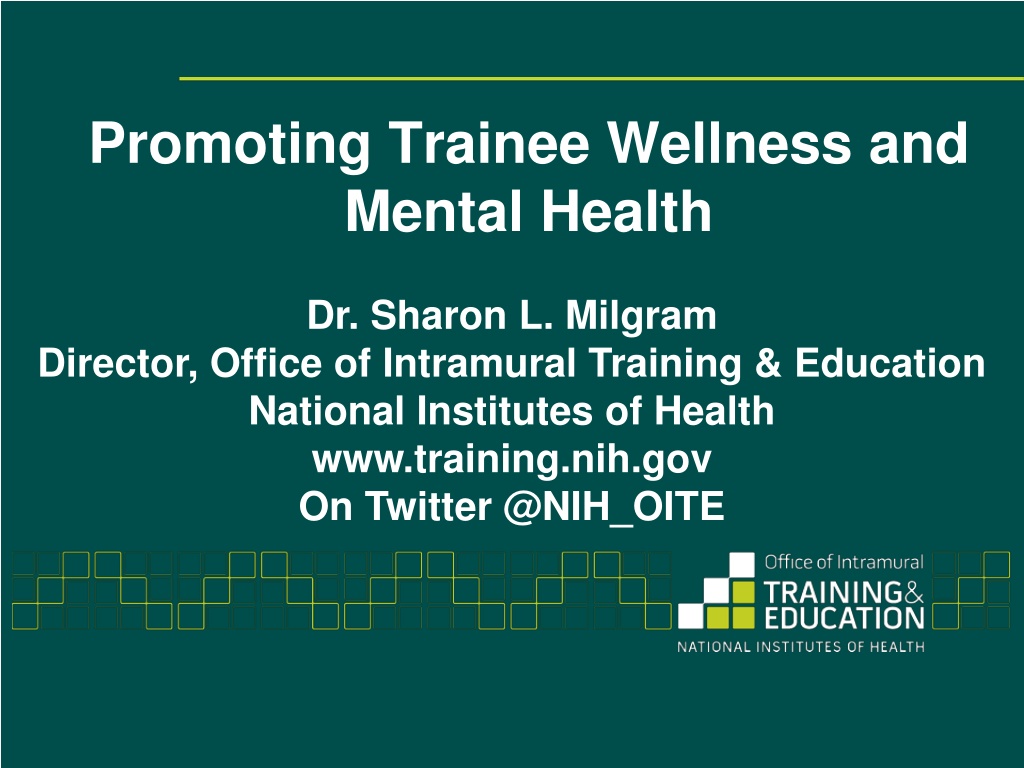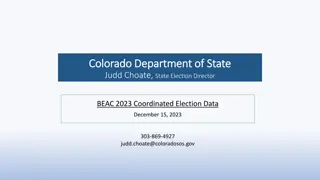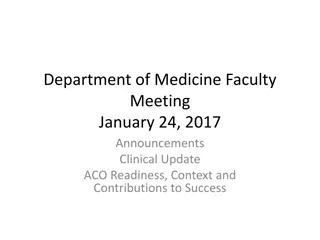Promoting Trainee Wellness and Mental Health: Strategies for Resilience
Dr. Sharon L. Milgram from the National Institutes of Health emphasizes the importance of supporting trainees dealing with various stressors beyond academic challenges. The focus is on building resilience, establishing wellness practices, and fostering a supportive community. Three key goals are outlined to help trainees succeed while managing stress and mental health concerns. Practical tips for enhancing resilience and links to valuable resilience resources are provided.
Download Presentation

Please find below an Image/Link to download the presentation.
The content on the website is provided AS IS for your information and personal use only. It may not be sold, licensed, or shared on other websites without obtaining consent from the author. Download presentation by click this link. If you encounter any issues during the download, it is possible that the publisher has removed the file from their server.
E N D
Presentation Transcript
Promoting Trainee Wellness and Mental Health Dr. Sharon L. Milgram Director, Office of Intramural Training & Education National Institutes of Health www.training.nih.gov On Twitter @NIH_OITE
We Train Thresholders Who may be dealing with complicating contextual factors, beyond the normal stress of doing science Financial strain, including food and housing insecurity Extent of support network and/or family challenges Membership in marginalized communities 1st generation college/graduate student International status Impact of past or recent trauma [Chronic] illness, including emotional/mental health concerns Culture/atmosphere of program/lab News events, both nationally and internationally Who are smart problem-solvers who have accomplished a lot in their (relatively) short educational careers
Three Overlapping Goals To help trainees appreciate the link between stress management/wellness and school/career/life success To help trainees work through acute stressors with minimal disruption of their academic and research progress To better prepare ourselves to deal with more serious mental health concerns that impact some members of our community Requires three things: That we frame this as a wellness, not an illness, issue substantial personal and culture change at all levels Collaboration between PIs, trainees and institutional resource staff
Resilience The ability to navigate difficult situations with intention and ease; the ability to adapt and grow through adversity To be resilient we have to: Find community and engage with peers and mentors Be proactive and use resources to thrive Find purpose day-to-day Understand and acknowledge negative emotions Have strategies for dealing with distorted self-talk and imposter fears Develop our growth mindset Practice holistic self-care NOTE: A group is only as resilient as the individuals that make up that group and resilience starts at the top
Two Resilience Videos https://www.pathlms.com/ashg/webinars/5264 (From ASHG webinar series) https://videocast.nih.gov/summary.asp?Live=34801&bhc p=1 (from a workshop on resilience for NIH trainees)
To Make Wellness a Part of the Research Culture We Have To Decide - ourselves and as a community - that wellness is a priority for us, our research group and our community Have and articulate a conceptual model/definition of wellness Grounded in the view that to do well, we have to be well . Identify multiple points where wellness information/ activities can be highlighted or integrated into research group, program and department activities Develop comfort with using wellness language with trainees, faculty and staff
Holistic Health and Self-Care Requires paying attention to physical, mental, emotional, and spiritual wellbeing. Body Mind Heart Spirit
Wellness Assessment - Body Never 1 ..2 . .3 . 4 .... ..5 Always I am getting enough sleep (7-9 hours) I am eating balanced, nutritious meals I avoid excessive use of caffeine I avoid excessive use of alcohol and others drugs of abuse I am getting regular exercise (at least 3 times a week) I am getting regular health care for myself I take care of myself when I am sick, need rest, or just need a break
Wellness Assessment - Mind Never 1 ..2 . .3 . 4 .... ..5 Always I avoid getting caught up in perfectionism I focus on the present vs. rehashing the past or worrying about the future I avoid negative or deceptive self-talk I practice self-affirmations and positive self-talk I avoid judging myself compared to others I give myself time to explore and learn about new things I am open to counseling as a tool to maintain and improve my health and wellbeing
Wellness Assessment - Heart Never 1 ..2 . .3 . 4 .... ..5 Always I m in touch with and let myself feel all my emotions I reach out to others for support when I need it I communicate my needs and feelings directly and honestly I make time to spend with my friends and family I engage in activities that are fun and relaxing I avoid extreme use of my phone as a coping tool/ avoidance strategy I demonstrate compassion for myself and others
Wellness Assessment - Spirit Never 1 ..2 . .3 . 4 .... ..5 Always I feel connected to something that is bigger than me however I define that I seek out resources (practices, activities, people, places) that nurture me spiritually I reflect on and invest in what is meaningful to me I read writings or watch media that are inspirational to me I think of and care about the lives of others who are different than me I allow time to just be (human being vs. human doing) I engage in activities that support my life s purpose
So Where are you doing well? Where might you improve? What about the wellness of your research group/program?
Stress Physical, mental or emotional pressure or tension DISTRESS is negative stress Can be short- or long-term feels unpleasant Causes anxiety or concern and can lead to mental and physical problems Perceived as outside of one s coping abilities Decreases performance EUSTRESS is positive stress Short-term, moderate can feel exciting Motivates, focuses energy Perceived as within one s coping abilities Can improve performance
Fallout from Stress Significant decline in school or work performance; impacts on individual progress and team science Missing classes or work Working excessively, but not smartly Not dealing with critical responsibilities and deadlines Unable to successfully navigate difficult conversations and group dynamics Isolation and withdrawal
Common Signs of Distress (I) Verbal Directly talking about the issue Raising an issue, but minimizing it Denial of real problems, It s fine, I m fine Excessive and unreasonable self-blame Excessively rapid or abnormally slow speech Incoherent speech Respiratory and related changes Hyperventilating, rapid breathing or breathlessness Sweating or dizziness
Common Signs of Distress (II) Changes in appearance Hygiene, self-care Weight gain or loss Changes in energy level Excessive fatigue or subdued Manic restlessness or hyperenergetic Emotional signs Changes in affect, emotional presentation Flooding with emotion Extreme mood changes Feelings of helplessness, hopelessness Significant irritability
Common Signs of Distress (III) Cognitive signs Confused thinking Difficulty concentrating Excessive worrying, fears Physical presentations Somatic complaints Sleeping or eating too little or too much Self-medicating, such as with alcohol, drugs, electronics Self-injury
Mental Illness Cognitive, emotional, or behavioral problems that lead to significant impairment, distress, and/or an inability to cope with the ordinary demands of life The severity of illness can vary from mild to moderate to severe and can change over time Efforts to cope with the mental illness can lead to maladaptive behaviors Individuals may have a dual diagnosis and suffer from more than one mental illness at a given time Many people exhibit some symptoms without mental illness
Any Mental Illness Any mental illness (AMI) is defined as a mental, behavioral, or emotional disorder. AMI can vary in impact, ranging from no impairment to mild, moderate, and even severe impairment.
Anxiety Persistent or extreme worries or fears that can be overwhelming and that impair normal functioning The fear is disproportionate to the reality and the anxious person has difficulty having perspective Anxiety can result in Emotional distress Physical symptoms Cognitive distortions Behavioral maladaptation
Types of Anxiety Anxiety can be generalized or very specific in nature Generalized Anxiety Disorder (GAD):excessive, recurring worry about life routines and situations including health, work, and social interactions Phobias: intense fear of or aversion to specific objects or situations Obsessive Compulsive Disorder: repetitive, unwanted, intrusive thoughts (obsessions) and irrational, excessive urges to do certain actions (compulsions) to stave off imagined harms Panic Disorder: recurrent, unexpected and sudden periods of intense fear accompanied by physical and psychological symptoms Social Anxiety Disorder: fear of social or performance situations
Depression A common, serious mood disorder that can interfere in the ability to work, eat, sleep, socialize, or otherwise participate in one s life Episodic periods of a decrease in energy or happiness levels from typical or baseline Negative thoughts and perspective on self and the world Persistent feelings of sadness and worthlessness A lack of desire to engage in formerly pleasurable activities often leading to withdrawal Exhibiting helplessness or hopelessness
, Types of Mood Disorders Major Depressive Disorder:characterized by severe symptoms that affect how you feel, think, and handle daily activities Bipolar Disorder: also known as manic-depressive illness, is a brain disorder that causes unusual shifts in mood, energy, activity levels, and the ability to carry out day-to-day tasks Mania:characterized by high energy and activity levels and extreme elation Dysthymia: apersistent, chronic form of depression, not as severe as major depressive disorder Seasonal Affective Disorder:the onset of depression during the winter months Postpartum Depression: full-blown major depression during pregnancy or after delivery
PIs and Program Staff Are Critical First Responders We need resources to respond and refer appropriately We need to stay in our lane
First Principles People have a universal human need too be seen, valued and heard for who they are Our goal is to make our trainees feel seen, valued and heard - and that is no easy feat because one size does not fit all This is further complicated by the power differential between PIs and trainees/program directors various contextual factors, individual personalities and identity issues the fact that we need to get work done
Things I Try To Keep In Mind Many problems can t be solved; however, they can be respectfully acknowledged Whoever does the work, does the learning Means putting aside my tendency to want to tell them what to do And two tips for getting a more complete story Sitting in silence (or allowing them some time to cry without jumping in) Asking How and What questions rather than Why questions
Helpful Communication Strategies (I) Show appreciation for their trust in you Thank you for sharing that Listen actively Give your full attention and indicate that you are engaged Reflect back what you heard to confirm understanding Encourage sharing with open- vs. closed-ended questions Keep the focus on them and where they are at at the moment Do not jump into problem solving/fix-it mode too quickly (or at all) Allow pauses and time for them to gather their thoughts Encourage them to be a part of the solution Do not immediately share a story as this discounts their experience Acknowledge the difficult emotions that come up Allow expressions of emotions without an immediate cut-off
Helpful Communication Strategies (II) Acknowledge the difficulty or challenge That must have been really hard for you; I m so sorry that happened. Express genuine interest Tell me about the career workshop you went to How was that hike with your friends last Saturday? Express confidence in them I really think you can do this; you ve handled hard things before. Encourage the use of resources Is there anything here at UC or in the community that might be helpful? Keep the door open Feel free to come back to talk again. Let s meet again next week, or sooner if you need to.
Helpful Communication Strategies (III) Use open and nonjudgmental language Instead of Oh, you shouldn t feel ____. , try it is reasonable to feel ________ about the review and .. Instead of Why in the world did you do that? try Can you share your reasoning with me? Help trainees determine a better course of action What do you think would be a better way to handle this next time? We all make mistakes; the key is to learn from them. What might you learn from this? Be honest and kind, especially when saying hard things I know this is hard to hear, but it s important that we discuss what happened ..
Know About Internal Resources In the student s program In your Deans Office, Program Offices, etc. Counseling Center/Student Health Center Ombuds Office Wellness and fitness resources Student health insurance policy Student affinity groups/interest groups International office Title IX office Important making a named referral and closing the loop is often the difference between great, good and not so good outcomes
Talking With Students If they come to you Thank them for sharing Acknowledge the difficulty Help them explore strategies and resources and/or refer to appropriate resources Explicitly encourage the use of resources Thank them sharing and set a time to follow up Close the loop on any resources you referred them to If you notice behavioral changes that concern you Use SBI strategy to describe what you have noticed but do not interpret the behaviors you observed Express your concern for them and their progress in your program; avoid threats and implied threats Continue as outlined above
Common Barriers To Counseling Stigma broadly, in their family, community and in the scientific community Time away from school/lab Financial issues Lack of understanding about counseling in general Overwhelming to begin the process or a bad experience with counseling in the past NOTE: PIs have influence on some of these barriers!
A Chance To Practice! While talking with your student about their lack of progress in your group, the student shares that they recently had a falling-out with their parents over religion. They have not spoken to their parents for several months (they used to talk several times per week) and are angry and upset about what happened. Beyond that, they are concerned about finances since their parents have been helping them out with rent and car insurance payments. The student acknowledges that this stress is greatly impacting their ability to focus on coursework and lab.
PIs vs. Program Directors Different boundaries, time commitments, responsibilities, and level of comfort discussing health/mental health concerns with their trainees Best scenario is that the PI Listens, acknowledges the difficulty their trainee is facing, and expresses support Explicitly encourages the use of resources and refers them to the appropriate staff in the program, or other resources in the University Makes it clear that it is fine that they take time away from research responsibilities to resolve the issue or to attend to their health and well-being
YOU Can Make a Difference If You Know Your Role and Stay In Our Lane An informed, aware and caring PI and/or program director who knows the signs of distress without over-interpreting them Not a mental health counselor, social worker, parent, or friend Someone who: Listens well Observes carefully Helps trainees access resources Talks directly with students about their health and well-being (while remembering appropriate boundaries) Models good attitudes and behaviors Seek advice from experts early and often
We Are Role Models Complete a self-care assessment and develop your own self- care plan; also, develop a research group plan Read articles/blogs/books, and use apps, related to self-care Attend trainings/workshops on stress management, personal wellness, resilience, mindfulness, etc. Attend workshops focused on trainee career development and wellness needs; support your staff to do the same Create a supportive circle of colleagues who focus on more than the science Create and maintain good working relationships with institutional support staff and systems
Some Things You Can Do Dedicate a lab meeting, or have a lab retreat, to talk about wellness and work life boundaries Attend a workshop together with your research group here or at a national meeting Plan a wellness event together with your research group (happy hour is NOT a wellness activity) Support the development of institutional wellness resources for trainees and staff Explore your career biases and do something about them Help bring appropriate management and mentoring workshops to your campus and scientific community























